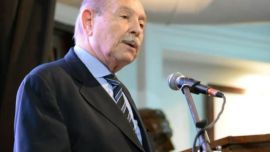The message of the ballot-box in last Sunday’s midterm elections was that everybody had something to celebrate – those who really won and very clearly, namely Juntos por el Cambio; those who reduced the difference from the PASO primaries, Frente de Todos and the emerging forces: Avanza Libertad and the Frente de Izquierda.
The relative atomisation might not be an obstacle for governability, given the relative weakness of each sector, strengthening those who emerge as leaders.
Argentine politics goes Italian
Power is fragmented into multiple parties. The left is growing thanks to its best election in history while the right has been reborn under Javier Milei and also José Luis Espert. Within the two main coalitions PRO sees City Mayor Horacio Rodríguez Larreta with a recovered Mauricio Macri sharing part of the leadership, while PRO as a whole is dividing power with an also renascent Radicalism. Within Frente de Todos, Kirchnerism is no longer the senior partner while the territorial Peronism of the hinterland has recovered its appetite for power, empowered precisely by the capitis deminutio of the crestfallen La Cámpora. Instead of a “league of governors” like that sustaining Eduardo Duhalde in 2002, it now has two – one headed by Tucumán’s Juan Manzur competing with the rebels of Córdoba’s Juan Schiaretti.
Independently of the party brands, there are six ideological spaces: 1) The unabashed right with Milei and Espert heading the libertarians; 2) The left which pipped the Peronists in Jujuy; 3) The hawks on the right wing of PRO; 4) The PRO moderates who share centrist values with the Radicals and the Civic Coalition; 5) The left wing of Frente de Todos: Kirchnerism and La Cámpora; 6) The territorial Peronism of the governors, Greater Buenos Aires mayors and the trade unions. Left, right, centre-left, centre-right and a centre in both the main parties.
It might be conjectured that the bipartisan Argentina of the second half of the 20th century between Peronists and Radicals collapsed in 2001 and tried to reconstruct itself as from 2015 with two coalitions, while elsewhere a two-party system is a phenomenon increasingly circumscribed to the Anglo-Saxon world with Tories and Labour in Britain and Republicans and Democrats in the United States.
Alberto Fernández ‘strengthened’
The president had already announced that there would be no immediate changes to the Cabinet when he went out to vote last Sunday morning. Nor did the Cabinet changes after the PASO primaries end up reflecting expectations.
Interior Minister Eduardo “Wado” de Pedro’s resignation was not accepted, as presidential supporters might have liked, and he stays on, but since various governors no longer trust him, precisely because of that resignation, Cabinet Chief Manzur acts as the interior minister. Ditto with Santiago Cafiero – he is now foreign minister but behind the scenes he continues performing for the president the same tasks as when he was Cabinet chief. Economy Minister Martín Guzmán and Strategic Affairs Secretary Gustavo Beliz (another shadow Cabinet chief) were not even shuffled.
Alberto Fernández probably feels, paraphrasing the title of Macri’s book, that he has a “Segundo tiempo (“Second half)” with the remainder of his own presidential term. In that direction he has announced that in the first week of December he will send to Congress an economic plan covering several years as the prelude to the final stage of the agreement with the International Monetary Fund, which has asked for exactly that, giving it parliamentary status and obliging the opposition to underwrite it. It might also be the basis for an anti-inflationary plan via an agreement between management and trade unions in the framework of the Socio-Economic Council to align next year’s collective wage bargaining and price increases with that plan for the next few years.
With no more pandemic and with Vice-President Cristina Fernández de Kirchner weakened by her own overreaction to the PASO defeat, the relationship of forces between the current and former presidents (although both lost) could favour Alberto Fernández.
With 25 months still left living in the Olivos presidential residence and a son on the way in April, having blown the expectations of him in the first half of his term and ceased to be a natural candidate for re-election with nothing more to lose, he might even end up winning something.
PASO ‘comebacks’
For the third time running the PASO results were not completely confirmed two months later by the elections. Back in 2017, Cristina Fernández de Kirchner’s Unidad Ciudadana won in Buenos Aires Province, only for the opposition’s candidate Esteban Bullrich to triumph in the midterms. In 2019 and in 2021, the reduction of the PASO winner’s supremacy in the elections was so significant that you might even speak of a comeback for Macri in 2019 and for Victoria Tolosa Paz in 2021. Would the midterm results have been the same without the PASO to trigger change and anticipate the electoral mood?
Changes are irreversible, but slower
Peronism has not been extinguished, nor has Kirchnerism ceased to be the party of Greater Buenos Aires. The relationship between social class and voting continues to be preponderant. Juntos por el Cambio stacked up overwhelming differences over Frente de Todos in the downtown areas of the City of Buenos Aires, Santa Fe, Córdoba and Mendoza. But Kirchnerism managed, via the votes of Greater Buenos Aires, to turn around an election negative for the government throughout the interior of Buenos Aires Province, which voted for Juntos. Voting for the opposition in the richest sectors of the country and for the government in the poorest continues being a trend.
The nationalisation of Juntos por el Cambio
As Jaime Durán Barba pointed out live on air on election night, a decade ago Cambiemos was little more than a municipal porteño party – now it has deputies in every province when 10 years ago it had no candidates save in historically Radical areas. In just six years, it has doubled its number of senators from 15 to 31. If they get to govern in 2023, Juntos will not have the excuse of lacking support in Congress – if they win the next elections, they will pass to having majorities in both chambers.
Youth and the extremes
The extraordinary growth of the libertarians and the left have one element in common – the mostly youthful vote of both extremes.
In the case of Milei/Espert the aspiration to cosmopolitan success arrives from the internationalisation of mass communications, especially the Internet. In the case of the left, the emergence of a crucial issue where the left has a competitive advantage: climate change and ecology. Green parties have grown worldwide thanks to the youngest.
Kirchnerism slips to third in Santa Cruz
The clearest symptom of the end of a political cycle of a dominant Kirchnerism is the result from the province which gave it birth. In Santa Cruz, the Ks not only trailed Juntos por el Cambio but also the provincial party of ex-governor Sergio Acevedo, who resigned in the times of Néstor Kirchner due to public works overpricing just like today’s Supreme Court Chief Justice Horacio Rosatti.
Cristina Fernández de Kirchner, who first entered the Senate in 2001 representing Santa Cruz, could not aspire to repeat the same as Carlos Menem did in his native La Rioja until his death. She and her son Máximo still have territory in Greater Buenos Aires left and by extension Buenos Aires Province but the improvement in the results from the PASOs was the merit of local mayors, not Kirchnerism nor La Cámpora. The end of an era.






















Comments